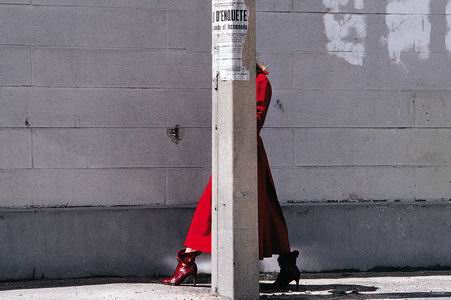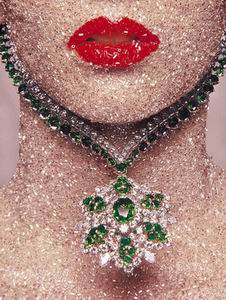Shanghai Daily news

A photograph taken by Bourdin for the 1975 Charles
Jourdan shoes advertising campaign. ¡ª Courtesy of The Guy Bourdin
Estate/Art+Commerce Anthology

One of Guy Bourdin¡¯s photographs for the January 1970
issue of French Vogue. ¡ª Courtesy of The Guy Bourdin Estate/Art+Commerce
Anthology
Some 20 years ago, a French fashion photographer brought
several European models to China and had them pose at the Temple of Heaven and
on the Great Wall in Beijing, in Suzhou¡¯s Gardens and along Wuxi¡¯s ancient
narrow streets.
The contrast between the sensual and exotic looking women
from Europe and the mysterious, traditional China that was in the background was
extremely striking and has proved to be timeless. The photographs appeared in
French Vogue magazine and the idea has been copied again and again by other
photographers.
Now the ground-breaking pictures have returned home to where
they were born to commemorate the work of the late avant-garde photographer ¡ª
Guy Bourdin (1928-91).
Bourdin¡¯s works have been on display in the National
Art Museum in Beijing and now they¡¯re coming to the Shanghai Art Museum. The
exhibition is also part of ¡°The Year of France in China¡± celebrations.
Bourdin, along with Helmut Newton, is considered to be one of the most
revolutionary fashion photographers of the second half of the 20th
century.
His images of faceless models, worked into beautifully composed
minimalist compositions, look as startling today as they did decades ago, when
they first appeared in top fashion magazines.
For example, two semi-nude
women, leaning over a sink full of shoes, help each other on with bikinis, or a
woman in a skin-tight bathing suit is draped over a table, her back towards the
viewer, staring at herself in a mirror.
Some critics put down his works for
being too sexual, violent or even macabre.
However, others say his imagery
made such a huge impact on both commercial and fine art photography that it
continues to resonate today.
¡°I don¡¯t see something sexual, pedophile or
violent in my father¡¯s work,¡± says Samuel Bourdin, who has come to Shanghai to
unveil the exhibition. ¡°I only see desire and seduction in these photos and
they¡¯re different things.
¡°My father studied drawing and painting. Being a
painter changes everything. He came from a different background. That makes him
different as a photographer. It¡¯s a whole different composition.¡±
The
large display of Bourdin¡¯s work has only been made possible through the hard
work and dedication reassembly of his son Samuel. It took him almost seven years
of litigation to force some of his father¡¯s ¡°women¡± to return the old
photographs.
¡°Once I felt rather depressed about it all,¡± Samuel admits. ¡°My
father was not a financially responsible man. He wanted his work to be perfect
so he always did it regardless of expense. Actually he was in debt when he was
dying.¡±
The exhibition includes modern prints, black and white 1950s vintage
prints, Polaroids, cinefilms, a landscape slide show and the results of informal
experiments. The modern prints are a selection mainly from 1970s and early 1980s
and show off their
timeless qualities. The exhibition reveals the wide
spectrum of Bourdin¡¯s artistic development.
The Polaroids series are
photographs he took while travelling for his fashion assignments or on personal
trips. He used the Polaroid camera to record his vision of the world. Visitors
can also see some original footage that Bourdin shot on 8mm and 16mm film during
1971 and 1975.
Born in 1928, Bourdin showed precocious artistic talent and
fierce ambition in his youth in post-war Paris. He presented himself to Man Ray
in the early 1950s and was then spotted by French Vogue, where he went on to
create some of the most sensational editorial images seen in more than a
generation.
His advertisements for Charles Jourdan shoes and Bloomingdales
in the mid- 1970s were the high point of his career and landmarks in the field
of advertising. Throughout his life, Bourdin worked at a relentless pace and
some of his most remarkable images recall the surrealist films of Luis Bunuel or
David Lynch.
Bourdin strengthened his stark images with an eye for the
absurd and the humorous despite the often morbid nature of his photographic
narratives such as the depiction of models lying lifeless on beds, or even chalk
outlines positioned near the wheels of a limousine. His palette is filled with
glaring, raw, clashing, saturated colors.
Unfortunately, Bourdin was not a
natural self-promoter, unlike, say Helmut Newton. Bourdin thought little of his
¡°gift to posterity.¡± He did not collect his works or make any attempt to
preserve them.
As a result, Bourdin¡¯s influence on subsequent generations of
photographers has been somewhat underestimated. Although he worked for French
Vogue for 30 years not many collections of his works were published.
It
is said that Bourdin himself wanted his work destroyed after his death
which came in 1991. The fact that he had not collected it all together actually
saved it from destruction. Samuel says it is not true that his father objected
to having a book of his photos published. ¡°He was working on a photo book the
year he died,¡± he says.
As for Samuel, he had a love-and-hate relationship
with his father. He hadn¡¯t really admired or paid attention to his father¡¯s
works before he died.
But afterwards he gave up his own work ¡ª he was a
painter based in New York ¡ª and began to collect and organize his father¡¯s
photos. He also worked at publishing books about his father¡¯s photographic
creations and assisted in the making of a documentary about his father¡¯s
life.
But, eventually, he says he will resume a career of his own. It may
sound very impulsive but he wants to move to Shanghai and send his fiveyear- old
daughter to a local primary school so she can learn Chinese.
¡°This city is a
happening place. Anything can happen,¡± he says with a laugh.
Date: June 4-19, 9am-5pm
Venue: Shanghai Art Museum,
325 Nanjing Rd W.
Admission: 20 yuan
Tel:
6327-2829



